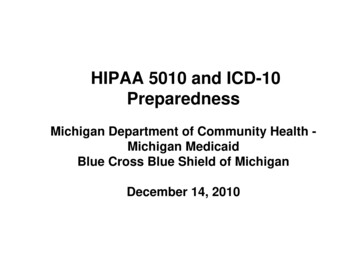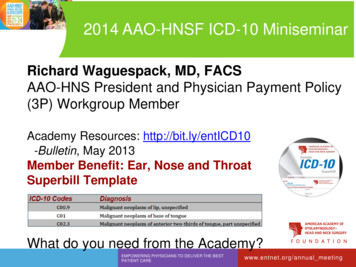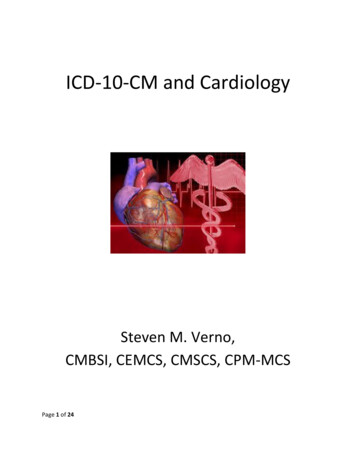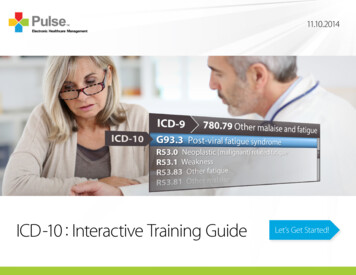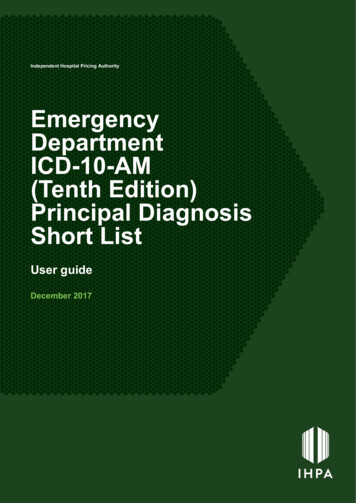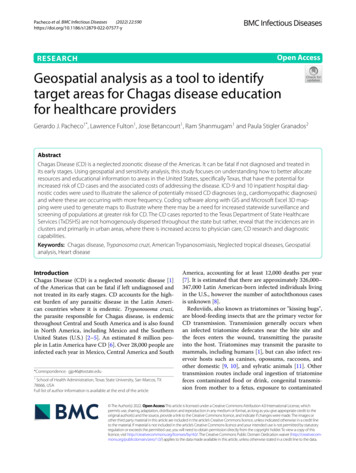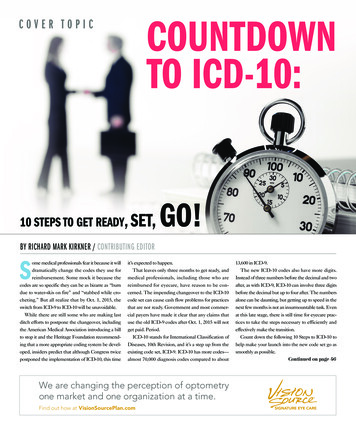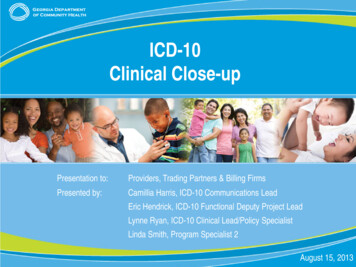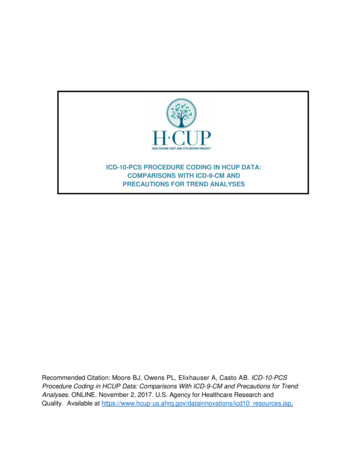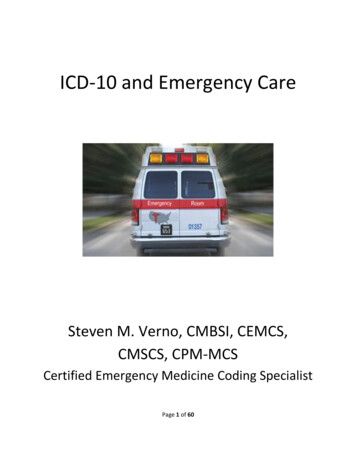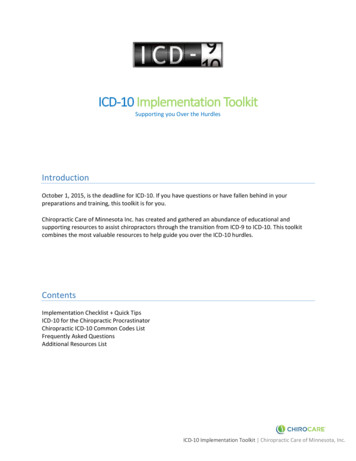
Transcription
ICD-10 Implementation ToolkitSupporting you Over the HurdlesIntroductionOctober 1, 2015, is the deadline for ICD-10. If you have questions or have fallen behind in yourpreparations and training, this toolkit is for you.Chiropractic Care of Minnesota Inc. has created and gathered an abundance of educational andsupporting resources to assist chiropractors through the transition from ICD-9 to ICD-10. This toolkitcombines the most valuable resources to help guide you over the ICD-10 hurdles.ContentsImplementation Checklist Quick TipsICD-10 for the Chiropractic ProcrastinatorChiropractic ICD-10 Common Codes ListFrequently Asked QuestionsAdditional Resources ListICD-10 Implementation Toolkit Chiropractic Care of Minnesota, Inc.
ICD-10 Implementation Checklist Quick Tips Watch ChiroCare’s “Gauging ICD-10 Readiness” webinar with your staff members. This recordingprovides a quick 60-minute overview of the transition basics. Compile a list of all the places (paper and electronic) ICD-9 codes are used in your clinic today.Some examples may include routing slips, billing paperwork, accounts receivable, etc. Refer to ChiroCare’s Chiropractic ICD-10 Common Codes List codes (included in this toolkit andavailable online) for a preliminary list of common ICD-10 codes chiropractic diagnoses. Use the inventory sheet of ICD-9 codes you collected from February to identify what processes, formsand systems need to change for the October 1, 2015 deadline. Modify these policies and procedures.Revise these paper forms and templates. Just about everyone in your office will need some sort of training, including medical coders andclinical staff. Make sure everyone is comfortable with codes as well as workflow changes – especially ifyou have new or upgraded systems. Conduct internal tests. Review ChiroCare’s ICD-10 Internal and External Testing Proceduresdocument offers some great tips to help get you started. Work out any testing errors internally or with vendors. Practice coding with ICD-10 and validate supporting clinical documentation processesQuick Tips Bill by date of service (DOS) – use ICD-9 codes for DOS until 9/30/2015; and ICD-10 codes should beused on all claims with DOS on or after 10/1/2015 Claims for DOS on or after 10/1/2015 that use ICD-9 codes will be denied – there is no grace period Chiropractic manipulation codes are the M99.XX codes Some codes have three digits and others have seven digits to be complete. Double-check the tabularlist to be certain the code is a complete code! Combination Codes are new with ICD-10 (e.g., lumbago with sciatica (right) is one code M54.1) Watch for exclusion codeso Excludes 1 mutually exclusive code - consider these codes INSTEAD (e.g., 54.5 low backpain excludes S39.012 low back strain)o Excludes 2 not includes - consider this code IN ADDITION (e.g., strain S16.1xxx andsprain S13.4xxx may both be diagnoses)ICD-10 Implementation Toolkit Chiropractic Care of Minnesota, Inc.
ICD-10 for the Chiropractic ProcrastinatorPresented ByChiropractic Care of Minnesota, Inc. (CCMI)Authored ByDr. Evan Gwilliam, DC, MBA, BS, CPC, CCPC, NCICS, CCCPC, CPC-I, CPMA, MCS-PIntroductionYou have put it off long enough. It is time to become proficient with ICD-10 or face the risk of claims notbeing paid for dates of service beginning October 1, 2015. The following pages contain tips andsuggestions on how to get started with the new coding approach. However, remember that learningICD-10 is a bit like learning to speak a new language - it cannot be taught in a few pages. Be sure to alsocheck out additional resources at the end of this Guide to support you over the ICD-10 hurdles.
Table of ContentsICD-10 Structure & Fundamentals . 2-3ICD-10 Terminology & Definitions . .3-5General Tips .6Strategies for Finding the Right Codes 6-7How to Use the ICD-10 Coding for Chiropractic Book .7Where to Find More Information .7ICD-10 Structure & FundamentalsICD-10 codes are organized into chapters, separated by body system or condition, just like ICD-9.Chiropractors will mostly use codes from the following chapters of the official Tabular List, which isabridged in ChiroCode’s ICD-10 Coding for Chiropractic book: Chapter 6 (G Codes – Diseases of theNervous system), Chapter 13 (M Codes – Diseases of the Musculoskeletal System and ConnectiveTissue), Chapter 18 (R Codes – Symptoms, Signs and Abnormal Clinical and Laboratory Findings, NotElsewhere Classified), Chapter 19 (S Codes - Injury), and maybe Chapter 20 (V, W, X, and Y Codes –External Causes of Morbidity).ICD-10 codes contain up to seven characters and they contain numbers as well as letters. The first three characters are the category; all codes in the same category are a relatedcondition (i.e. M47 is the category for Spondylosis).ICD-10 for the Chiropractic Procrastinator2
The next three characters provide detail about things like the anatomical site and severity;in some cases, they may be replaced by the “x” to ensure that the seventh characterremains in the seventh position.Be careful about specifying the difference between the number zero “0” and the letter “O”. Thesame is true of “1”, “L”, and “I.”The sixth character frequently denotes laterality (1 right; 2 left). When there is no bilateralcode, you need to list the right and left code separately.The seventh character for certain injury codes (encounter or episode of care) will usually onlybe used by chiropractors for sprain and strain codes (i.e. S23.3xx Sprain of Ligaments ofThoracic Spine.) The “ ” underscore indicates that a seventh character is required. They usuallyinclude the following three options.o A – Initial encounter: patient is receiving active treatment. Payers may recognize this asa phase of care, rather than a single visit. It may be required when establishing medicalnecessity for chiropractic care.o D- Subsequent encounter: routine care during the healing or recovery phase/supportcare. This may be considered appropriate for all visits after the initial visit, or it may beviewed as maintenance care.o S – Sequela: complications or conditions that arise as a direct result of the condition.This would be applied to a condition which is no longer present, but it led to anotherproblem, which is the primary reason for the encounter.ICD-10 Terminology & Definitions Acute Conditions - The medical conditions characterized by sudden onset, severe change,and/or short duration. Additional Diagnosis - The secondary diagnosis code used, if available, to provide a morecomplete picture of the primary diagnosis. And - Means "and/or" when it appears in a title or narrative statement. Example: S33 says“Dislocation and sprain”, which can mean either sprain and/or dislocation. Bilateral - For bilateral sites, the final character of the codes in the ICD-10-CM indicateslaterality. An unspecified side code is also provided should the side not be identified in themedical record. If no bilateral code is provided and the condition is bilateral, assign separatecodes for both the left and right side. Brackets [ ] - Punctuation found in both the Tabular List and the Alphabetic Index surroundingmanifestation codes to indicate that the manifestation should be sequenced after the diseasecode. Chronic Conditions - Medical conditions characterized by long duration, frequent recurrenceover a long period of time, and/or slow progression over time.ICD-10 for the Chiropractic Procrastinator3
Code Also - Instruction that tells the coder that more than one code could be assigned, but itdoes not imply any sequencing guidance. Generally the most serious condition should belisted first. Code First - Instructs the coder to assign the code for the underlying disease before the codefor the manifestation of the disease and generally accompanies a manifestation code. Thisnote is not common for musculoskeletal codes. Colon : - Punctuation found in the Tabular List when a term must be modified by the additionof another term in order to qualify it for assignment of a specific code or to a category. Combination Codes - A single code used to classify any of the following: two diagnoses; adiagnosis with an associated secondary process (manifestation); or a diagnosis with anassociated complication. Crosswalk/mapping - Moving from one code set to another. This is generally done withGEMs, but can be customized. Excludes - "Excludes" as used in ICD-9-CM indicates that the code should not be used, becauseanother code may be more appropriate. "Excludes" notes usually include suggestions of moreappropriate codes or code ranges. ICD-10-CM introduces two types of excludes: "Excludes1"and "Excludes2".oCodes/conditions listed in the "Excludes1" notes should not be used because thetwo conditions do not occur together. It may be helpful to think of the “Excludes1”list to be codes that might be suggested instead.oCodes/conditions listed in the "Excludes2" notes indicate that the conditions beingexcluded are not considered part of the subject condition, but that another codeshould also be assigned. It may be helpful to think of “Excludes2” codes to thosethat might need to be added to provide full detail.oCodes may have both, either or neither Excludes1 and Excludes2 notes. GEMs - Generated by the National Center for Health Statistics, this reference mappingattempts to include all valid relationships between the codes in the ICD-9-CM diagnosisclassification and the ICD-10-CM diagnosis classification. CMS warns not to code directly fromGEMs, as they only provide approximations. Note that GEMs frequently point to“unspecified” ICD-10 codes, which may lead to denied claims. Includes - Term that is accompanied by conditions that are examples of what may be includedin a specific category. NEC - “Not elsewhere classified” or “other specified” is used when the information in themedical record provides detail for which a specific codes does not exist. Example M53.86Other specified dorsopathies, lumbar region might be used for “facet syndrome”. The codedoes not name the condition, but the documentation does. Nonessential Modifiers - Terms that may coexist with the main term but do not change thecode assignment for the condition. These are generally contained within parentheses.ICD-10 for the Chiropractic Procrastinator4
NOS - “Not otherwise specified” or “unspecified” is used when the information in the medicalrecord is insufficient to assign a more specific code. Example: M54.9 Dorsalgia unspecified.The code is vague, but so is the documentation. Manifestation Codes - Certain conditions have both an underlying etiology and multiple bodysystem manifestations due to the underlying etiology. For such conditions, the ICD-10-CM hasa coding convention that requires the underlying condition be sequenced first followed by themanifestation. Wherever such a combination exists, there is a "use additional code" note atthe etiology code, and a "code first" note at the manifestation code. These instructional notesindicate the proper sequencing order of the codes, etiology followed by manifestation.However, these are uncommon for musculoskeletal diagnoses that are most likely to be usedby chiropractors. Medical Necessity - Services or supplies that: are proper and needed for the diagnosis ortreatment of a medical condition; are provided for the diagnosis, direct care, and treatment ofa medical condition; meet the standards of good medical practice in the local area; and arenot mainly for the convenience of the patient or doctor. Diagnosis codes convey thisinformation. Parentheses ( ) - Punctuation found in both the Tabular List and the Alphabetic Index thatsurrounds nonessential modifiers. Example: M99.1- subluxation complex (vertebral). Theword “vertebral” is not essential to the code description. Principle Diagnosis - First-listed/primary diagnosis code. The code sequenced first on amedical record defines the primary reason for the visit as determined at the end of theencounter. Signs/Symptoms - Codes that describe symptoms and signs, as opposed to diagnoses, areacceptable for reporting purposes when a related definitive diagnosis has not beenestablished (confirmed) by the provider. See - Term used in the Alphabetic Index to instruct the coder to refer to another term. See Also - Term used in the Alphabetic Index to instruct the coder to refer to another term ifdesired. Sequelae - A late effect is the residual effect (condition produced) after the acute phase of anillness or injury has terminated. There is no time limit on when a late effect code can be used.The residual may be apparent early, such as in cerebral infarction, or it may occur months oryears later, such as that due to a previous injury. With - Term used in the alphabetic index immediately following the main term, but notnecessarily in alphabetic order in the Alphabetic Index. It is defined as “associated with” or“due to”. If not specified in the documentation, the default is “without”.ICD-10 for the Chiropractic Procrastinator5
General ICD-10 Tips Claims for dates of service prior to October 1, 2015 must use ICD-9 codes. Claims for dates ofservice after October 1, 2015 must use ICD-10 codes.The ICD-10 code set was last updated in 2012, and will not change again until 2016Personal Injury insurance policies and workers compensation plans are not required to adoptICD-10 codes, but it is expected that they will. You are encouraged to contact them directly tomake sure.Do not code diagnoses documented as ‘probable’, ‘suspected’, ‘questionable’, ‘rule out’, or‘working diagnosis’ or other terms indicating uncertainty. Example: if you suspect a discherniation, you may need MRI to confirm before using a disc related diagnosis code.Signs and symptoms (mostly Chapter 18, R codes) should only be coded if a more definitivediagnosis has not been identified, or if they are not routinely associated with other codesassigned to the encounter. External Cause codes (Chapter 20, V, W, X, and Y)o Do not provide a diagnosis, rather they provide data about the location, activity, orcircumstances of an injury or poisoningo Are not mandatory, but voluntary reporting is encouragedo May be used by chiropractors with acute injuries, such as auto accidents or worker’scomp claimso Are always listed last on a claim formStrategies for Finding the Right CodesGeneral Strategies1. Use GEMs mapping in the ChiroCode book (pages 56-137) or your EMR software. Thenconfirm the choice in the Tabular List. Be wary of unspecified codes.2. Use the Common Codes list in the ChiroCode book (pages 44-56). Then confirm the choice inthe Tabular List. Be sure to review all the instructional notes within the Tabular List.3. Look up the key terms from the provider documentation in the Alphabetic Index (pages 455472). Then confirm the code(s) in the Tabular List. Consider synonyms if you can’t find theterm you are looking for.Improving ICD-10 documentation1.2.3.4.Find ICD-10 codes for existing records in your office.Compare the existing documentation to the new codes.If inadequate, add details to a practice record.For every patient that presents in the future with that condition, include the new details inyour documentation.ICD-10 for the Chiropractic Procrastinator6
Administrative steps Be prepared for the possibility of delayed payments due to issues regarding processing andpayer policies for new codes. Consider securing financing to allow you to meet obligationsshould revenue temporarily decline.Reach out to payers and your clearinghouse and ask if they will accept test claims prior toOctober 1, 2015.Plan to train your entire office a little each week. Consider using articles from trade journals orreading the first 43 pages of the ChiroCode ICD-10 book.How to use the “ICD-10 Coding for Chiropractic Book” The first 43 pages summarize all you need to know about ICD-10:detailed explanations of the terms identified in this guide.The “Commonly Used Codes” (about 12 pages) section provides youwith a shortcut list sorted by anatomical region. Note that this list isonly a best guess, since ICD-10 has not actually been used yet.The “Code Mapping” (about 90 pages) section provides you withGEMs tables to translate from ICD-9 to ICD-10 codes. Watch out forunspecified codes.The “Tabular List” (about 300 pages) contains an abridged version ofthe full code set. Most of the codes included are musculoskeletalconditions and acute injury codes (sprains and strains).o An arrow at the bottom of a page means highest specificity and if the code is bold, itmeans it is complete (right number of characters).o Pay particular attention to instructional notes at the level of each code character.The “Alphabetic Index” (about 20 pages) can be used to find codes by key terms that areincluded in the documentation. Beware that the index usually only provides the first three orfour characters of a code.The “Appendix” (about 40 pages) contains an abbreviated version of the official guidelines forICD-10 coding.Where to Find More Information Visit CCMI’s ICD-10 Transition Support web page for articles and other resourcesGo to ChiroCode.com and use coupon code CCMI20 to get 20 off ChiroCode’s “ICD-10 Codingfor Chiropractic” book. It contains everything you need to make the transition. (Please contactChiroCode directly with any questions regarding your order or the coupon code at (602) 9449877 and allow one week for delivery.)Visit CMS’ Road to 10 web page for free ICD-10 resources from MedicareICD-10 for the Chiropractic Procrastinator7
Chiropractic ICD-10 Common Codes ListThis is a preliminary list of common ICD-10 codes for chiropractic diagnoses. This is a common code list to be usedas a guide for coding and is not intended to represent all ICD-10 codes accepted by ChiroCare. Using codes on thislist does not guarantee that the claim will not be denied.Using valid ICD-10 codes can facilitate authorization, claims payments and support the medical necessity of theservice in case of review, audits or litigation. Codes must support neuromusculoskeletal (NMS) conditions, andrepresent the body regions requiring treatment. Please list the diagnosis primarily responsible for the treatment inthe primary position on the claim form. ChiroCare further recommends that the secondary, tertiary and quaternarydiagnosis positions on the claim form be used to report additional conditions/regions that are being treated.ICD-10Code Description/Condition NameDiagnosis CodeHeadacheR51HeadacheG44.201Tension-type headache, unspecified, intractableG44.209Tension-type headache, unspecified, not intractableG43.001Migraine without aura, not intractable, with status migrainosusG43.009Migraine without aura, not intractable, without status migrainosusG43.011Migraine without aura, intractable, with status migrainosusG43.019Migraine without aura, intractable, without status migrainosusG43.101Migraine with aura, not intractable, with status migrainosusG43.109Migraine with aura, not intractable, without status migrainosusG43.111Migraine with aura, intractable, with status migrainosusG43.119Migraine with aura, intractable, without status algiaSegmental and somatic dysfunction of cervical regionSprain of ligaments of cervical spine, initial encounterStrain of muscle, fascia and tendon at neck level, initial encounterCervical disc disorder with radiculopathy, occipito-atlanto-axial regionCervical disc disorder with radiculopathy, mid-cervical regionCervical disc disorder with radiculopathy, cervicothoracic regionOther cervical disc degeneration, occipito-atlanto-axial regionOther cervical disc degeneration, mid-cervical regionOther cervical disc degeneration, cervicothoracic regionSpinal stenosis, occipito-atlanto-axial regionSpinal stenosis, cervical regionChiropractic ICD-10 Common Codes List Chiropractic Care of Minnesota, Inc.
11M54.12M53.1G54.0Cervical, ContinuedSpinal stenosis, cervicothoracic regionTorticollisSpondylosis without myelopathy or radiculopathy, offipito-atlanto-axial regionSpondylosis without myelopathy or radiculopathy, cervical regionSpondylosis without myelopathy or radiculopathy, cervicothoracic regionJuvenile idiopathic scoliosis, cervical regionJuvenile idiopathic scoliosis, cervicothoracic regionAdolescent idiopathic scoliosis, cervical regionAdolescent idiopathic scoliosis, cervicothoracic regionNeuromuscular scoliosis, occipito-atlanto-axial regionNeuromuscular scoliosis, cervical regionNeuromuscular scoliosis, cervicothoracic regionOther specified dorsopathies, occipito-atlanto-axial regionOther specified dorsopathies, cervical regionOther specified dorsopathies, cervicothoracic regionRadiculopathy, occipito-atlanto-axial regionRadiculopathy, cervical regionCervicobrachial syndromeBrachial plexus M51.14M53.84M41.114M41.124M41.44Thoracic and RibsPain in thoracic spineSegmental and somatic dysfunction of thoracic regionSegmental and somatic dysfunction of rib cageSprain of ligaments of thoracic spine, initial encounterSprain of ribs, initial encounterSprain of chondrosternal joint, initial encounterIntervertebral disc disorders with radiculopathy, thoracic regionOther specified dorsopathies, thoracic regionJuvenile idiopathic scoliosis, thoracic regionAdolescent idiopathic scoliosis, thoracic regionNeuromuscular scoliosis, thoracic XXAS33.9XXAS39.012AM51.15M51.16M51.17Lumbosacral & PelvicLow back painSegmental and somatic dysfunction of lumbar regionSegmental and somatic dysfunction of sacral regionSegmental and somatic dysfunction of pelvic regionSprain of ligaments of lumbar spine, initial encounterSprain of sacroiliac joint, initial encounterSprain of other parts of lumbar spine and pelvis, initial encounterSprain of unspecified parts of lumbar spine and pelvis, initial encounterStrain of muscle, fascia and tendon of lower back, initial encounterIntervertebral disc disorders with radiculopathy, thoracolumbar regionIntervertebral disc disorders with radiculopathy, lumbar regionIntervertebral disc disorders with radiculopathy, lumbosacral regionChiropractic ICD-10 Common Codes List Chiropractic Care of Minnesota, Inc.
7Lumbosacral & Pelvic, ContinuedOther intervertebral disc degeneration, lumbar regionOther intervertebral disc degeneration, lumbosacral regionSpondylosis without myelopathy or radiculopathy, lumbar regionSpondylosis without myelopathy or radiculopathy, lumbosacral regionSciatica, right sideSciatica, left sideLumbago with sciatica, right sideLumbago with sciatica, left sideRadiculopathy, lumbar regionRadiculopathy, lumbosacral regionSacrococcygeal disorders, not elsewhere classifiedOther specified dorsopathies, thoracolumbar regionOther specified dorsopathies, lumbar regionSpinal stenosis, lumbar regionSpinal stenosis, lumbosacral regionJuvenile idiopathic scoliosis, thoracolumbar regionJuvenile idiopathic scoliosis, lumbar regionJuvenile idiopathic scoliosis, lumbosacral regionAdolescent idiopathic scoliosis, thoracolumbar regionAdolescent idiopathic scoliosis, lumbar regionAdolescent idiopathic scoliosis, lumbosacral regionNeuromuscular scoliosis, thoracolumbar regionNeuromuscular scoliosis, lumbar regionNeuromuscular scoliosis, lumbosacral 2AUpper ExtremitySegmental and somatic dysfunction of upper extremityCarpal tunnel syndrome, right upper limbCarpal tunnel syndrome, left upper limbAdhesive capsulitis of right shoulderAdhesive capsulitis of left shoulderBursitis of right shoulderBursitis of left shoulderMedial epicondylitis, right elbowMedial epicondylitis, left elbowLateral epicondylitis, right elbowLateral epicondylitis, left elbowSprain of right acromioclavicular joint, initial encounterSprain of left acromioclavicular joint, initial encounterSprain of right coracohumeral (ligament), initial encounterSprain of left coracohumeral (ligament), initial encounterSprain of right rotator cuff capsule, initial encounterSprain of left rotator cuff capsule, initial encounterStrain of muscle(s) and tendon(s) of the rotator cuff of right shoulder, initial encounterStrain of muscle(s) and tendon(s) of the rotator cuff of left shoulder, initial encounterOther injury of muscle(s) and tendon(s) of the rotator cuff of right shoulder, initial encounterOther injury of muscle(s) and tendon(s) of the rotator cuff of left shoulder, initial encounterChiropractic ICD-10 Common Codes List Chiropractic Care of Minnesota, Inc.
1M79.632M79.641M79.642M79.644M79.645Upper Extremity, ContinuedStrain of other muscles, fascia and tendons at shoulder and upper arm level, right arm,initial encounterStrain of other muscles, fascia and tendons at shoulder and upper arm level, left arm, initial encounterSprain of other specified parts of right shoulder girdle, initial encounterSprain of other specified parts of left shoulder girdle, initial encounterPain in right shoulderPain in left shoulderPain in right elbowPain in left elbowPain in right wristPain in left wristPain in right armPain in left armPain in right upper armPain in left upper armPain in right forearmPain in left forearmPain in right handPain in left handPain in right finger(s)Pain in left 93.411AS93.412AS93.421AS93.422AS93.431ALower ExtremitySegmental and somatic dysfunction of lower extremityAchilles tendinitis, right legAchilles tendinitis, left legAnterior tibial syndrome, right legAnterior tibial syndrome, left legAnterior tibial syndrome, unspecified legPosterior tibial tendinitis, right legPosterior tibial tendinitis, left legPosterior tibial tendinitis, unspecified legOther sprain of right hip, initial encounterOther sprain of left hip, initial encounterStrain of muscle, fascia and tendon of right hip, initial encounterStrain of muscle, fascia and tendon of left hip, initial encounterSprain of unspecified collateral ligament of right knee, initial encounterSprain of unspecified collateral ligament of left knee, initial encounterSprain of unspecified cruciate ligament of right knee, initial encounterSprain of unspecified cruciate ligament of left knee, initial encounterSprain of unspecified site of right knee, initial encounterSprain of unspecified site of left knee, initial encounterSprain of calcaneofibular ligament of right ankle, initial encounterSprain of calcaneofibular ligament of left ankle, initial encounterSprain of deltoid ligament of right ankle, initial encounterSprain of deltoid ligament of left ankle, initial encounterSprain of tibiofibular ligament of right ankle, initial encounterS46.811AChiropractic ICD-10 Common Codes List Chiropractic Care of Minnesota, Inc.
1M25.552M25.561M25.562M25.571M25.572Lower Extremity, ContinuedSprain of tibiofibular ligament of left ankle, initial encounterSprain of other specified muscles and tendons at ankle and foot level, right foot, initial encounterSprain of other specified muscles and tendons at ankle and foot level, left foot, initial encounterPain in right legPain in left legPain in right thighPain in left thighPain in lower right legPain in lower left legPain in right footPain in left footPain in right toe(s)Pain in left toe(s)Pain in right hipPain in left hipPain in right kneePain in left kneePain in right anklePain in left ankleM62.830M79.1M79.7Other Diagnoses (do not use as primary code)Muscle spasm of backMyalgiaFibromyalgiaChiropractic ICD-10 Common Codes List Chiropractic Care of Minnesota, Inc.
ICD-10 TransitionFrequently Asked Questions1. When is the ICD-10 compliance deadline?The ICD-10 deadline is October 1, 2015.2. Is it the Date of Service (DOS) that determines ICD-9 or 10?Yes. DOS before October 1, 2015 are submitted using ICD-9. DOS on or after October 1, 2015are submitted using ICD-10.3. What happens if I submit ICD-9 for DOS after October 1, 2015?The claim will be denied.4. Is there any grace period to submit ICD-9 after October 1, 2015?No. For DOS on and after October 1, 2015 – ICD-10 is required.5. Do ICD-10 codes need to be reported for all products?Yes. ICD-10 codes must be used for all services provided on or after October 1, 2015, regardlessof the type of insurance product the member holds.6. Codes change every year so why is the transition to ICD-10 any different from theannual code changes?ICD-10 codes are completely different from ICD-9 codes. Currently, ICD-9 codes are mostlynumeric and have 3 to 5 digits. ICD-10 codes are alphanumeric and contain 3 to 7 characters.The change is significant, so it is wise to begin your transition process now.7. Will ICD-10 replace Current Procedural Terminology (CPT) coding?No. The transition to ICD-10 is for diagnostic codes and does not affect CPT coding foroutpatient procedures and practitioner services.8. Why is the switch to ICD-10 happening?The Centers for Medicare & Medicaid Services (CMS) is requiring thetransition to ICD-10 because it allows for more accurate description of thep
ICD-10 Implementation Toolkit Chiropractic Care of Minnesota, Inc. ICD-10 Implementation Toolkit Supporting you Over the Hurdles Introduction October 1, 2015, is the deadline for ICD-10. If you have questions or have fallen behind in your preparations and training, this toolkit is for you.
